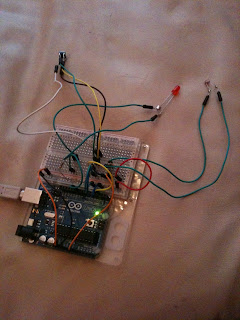Week 15 Log:
Week beginning 16/01/2012
This week involved the definition of the final project space: ‘transient memory’. It was defined in the blog here
This more specific definition facilitated thorough exploration of the final project space. There was exploration of the concept of ‘mementos’ and how this concept of an ‘active memento’ could be valuable.
A ‘transient memory’ system architecture was defined. There are four main elements within the concept of transient memory: conveying presence, the idea of an active memento and a secret memory channel. There are two options for collecting and transmitting data and these are active and passive: where the users have to intend to transmit information or don’t.
A paired architecture was designed that illustrated the movement of memories between two people using their devices.
A system architecture was also designed which illustrates how the system would work.
The final project proposal was developed for the deadline on January 24th. The presentation of the proposal itself was designed. Materials used were black mounting card and paper. Supplementary materials were provided on CD which included a presentation of the entire process week-by week as well as arduino media and academic resources.
The project proposal housing had a concept overview section, a section for the report and for the CD.
Early prototyping was also done this week. An arduino model was made and also Google sketch up models. The concept was titled ‘the ‘we’ chair’, and it conveyed presence as well as allowing the transmission of a message.
The arduino model was made using paper and various sensors. It is built into one device, but in the future it the devices will be separate with wireless connectivity. The chairs light up when they are ‘sat’ on, and the user can press a button to send a ‘HEY’ message. In future prototypes, experimentation will be done with customisable messaging and different interaction and output types. However, this prototype allowed functionality testing and illustrated how presence would be conveyed.
TITLE: The ‘we’ chair.
CONCEPT: Paired devices (chairs) detect when a person is sitting on them, and transmits a notifiation of this presence and a message. A light dependant resistor built into the seat detects when it is dark (someone sitting on it), and sends a message wirelessly to it’s partner device which turns a light on where they’re sitting (see images below). A message is sent in this prototype using a push-button. It currently only says ‘HEY’, but different functionality will be added in later prototypes according to feedback from the user groups.
AIMS: To convey presence and transmit memories
MEMORY LIFETIME: Limited to how long the memory sender is sitting in the chair
HOW: Arduino Uno board (Currently), Xbee wireless modules (future). At the moment for testing purposes everything is built onto one board: there is no distance seperation but it is fully functional. Also the message is displayed on the computer, where it would be displayed on an LCD screen or another standalone device, as in the google sketchup model.
COMPONENTS: Light Dependant Resistor (LDR), LED, Push-button
CONTEXT OF USE: Home (as depicted in google sketchup model).
Below are a photo and video of the sensors picking up when a person sits down: simulated by a finger on this micro model. The light lights up on the partner device.
Below is a video of the screen output when the button is pushed: this is simulated on the desktop environment here, but would have a standalone output in future prototypes.
Below is a google sketchup model of how the chair could look, and how it could be built as a life-size model.
Below is a usage scenario.
Step 1: Person A is sitting at home drinking tea.
Step 2: Person B sits on their sofa, and the chair sends a message to person A’s chair which lights up red, notifying person A of their presence.
Step 3: Person B decides to send a message to person A, so presses their button to say ‘hey’. This message is displayed on person A’s chair. Note: ‘Hey’ message is larger for illustrative purposes.
HOW TO IMPROVE ON THIS DESIGN: Build two standalone wireles devices. The chair devices would be purpose-built and would completely conceal any wiring. There would be customisable memory sharing: not just predetermined messages i.e. ‘HEY’. Explore different kinds of memories that can be depicted.
This week has involved conceptual definition and early prototype development.












No comments:
Post a Comment